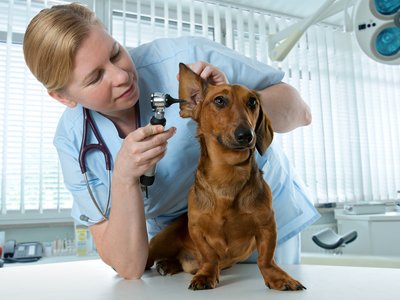When people think about getting a pet, they usually focus on the cuddle factor, the idea that they’ll have a companion or protector, a fuzzy friend. Of course, most also recognize that pets require care and money, but it seems that a whole lot of us underestimate just how much care and expense pets actually require. Certainly statistics bear this out. Up to 20 percent of cats and dogs entering homes are given up for adoption within six months.1 “Pet Overpopulation.” American Humane Society. 5 February 2015. http://www.americanhumane.org/animals/adoption-pet-care/issues-information/pet-overpopulation.html And of those, about 2.7 million are euthanized each year. As for the pets that remain in homes, they often get much less care than they need, as shown by the fact that veterinary visits are on the decline and chronic disease among dogs and cats has sharply risen.
The reason for the decline in pet health can at least partially be accounted for by rising pet obesity. As we reported recently, pets are getting fatter alongside their owners, and as a consequence, cases of canine diabetes have risen by 32% since 2006.2 Dale, Steve. “Pet health crisis: Americans skimp on preventative care.” 11 January 2014. USA Today. 5 February 2015. http://www.usatoday.com/story/news/nation/2014/01/11/pets-health-crisis-veterinarians/4301469/ In fact, more than half of the pets in the U.S. are now overweight, with one in five clinically obese, creating ideal pre-conditions for diabetes. But it isn’t just canine diabetes that’s increased. Reports show a 38 percent rise in canine arthritis and a 67 percent rise in feline arthritis in the eight years since 2007. Also, both dogs and cats have been suffering more thyroid and kidney disease than before, and apparently, even have more flea problems.
In spite of the rise in such serious health problems, dog owners are taking their pets to the veterinarian for routine care 21 percent less often than in the past, and cat owners 30 percent less. Veterinarians insist that annual preventative appointments are essential for all pets, in order to spot problems early while they can still be addressed. And yet, a 2012 study found that spending on heartworm preventives by cat owners had dropped by 28 percent in the years between 2007 and 2011, while flea and tick control spending went down by 20 percent.3 “Pet owners shying away from veterinary care, according to two new reports.” 10 March 2012. Veterinary News. 16 February 2015. http://veterinarynews.dvm360.com/pet-owners-shying-away-veterinary-care-according-two-new-reports Only about half of domestic dogs get heartworm preventative at all. That fact doesn’t necessarily indicate that pet owners love their animals less (case in point: 42 percent of dogs sleep in bed with their owners), but rather, that increasing costs and increasing ignorance about what pets need have created a situation where animals that end up in the vet’s office typically are in severe crisis.4 Burns, Katie. “Vital Statistics.” 16 January 2013. JAVMA News. 6 February 2015. http://www.avma.org/news/javmanews/pages/130201a.aspx
Perhaps the fact that that emergency visits to vet offices in the US have increased even as regular visits have decreased has contributed to veterinary spending actually increasing.5 Scheidegger, Julie. “Visits may be down, but veterinary spending is going up.” 21 May 2014. DVM360 Magazine. 7 February 2015. http://veterinarynews.dvm360.com/visits-may-be-down-veterinary-spending-going In fact, in the one year from 2013 to 2014, US pet owners increased spending at vet’s offices from 14.37 billion to 15.25 billion. That represents an 11 percent increase since 2012. It certainly costs plenty to visit the veterinarian-more than it did a few years ago. There are numerous factors contributing to the high costs such as: increasing costs to rent office space, the increased cost of paying salaries and health care costs for employees, the high cost of buying sophisticated equipment which often costs just as much as human equipment, and the high cost of student loan payback. The average veterinarian graduates $151,000 in debt from student loans, only slightly less than graduating medical doctors owe.6 “Too Many Indebted Veterinary Graduates Chase Too Few Jobs.” 9 July 2013. Veterinary Practice News. 7 February 2015. http://www.veterinarypracticenews.com/July-2013/Too-Many-Indebted-Veterinary-Grads-Chase-Too-Few-Jobs/ But while the average MD specializing in internal medicine starts earning $171,000 upon graduation, the average veterinarian earns only $66,000 or so. While medical doctors can pass off some of the cost of delivering care to insurance companies, pet health insurance still isn’t significant or omnipresent in the US, so the costs get passed on to pet owners. And given that a study just this week found that 64 percent of Americans name money worries as their greatest source of stress, taking care of Rover’s annual checkup might move down the list of priorities in tight cash times.7 Thompson, Dennis. “Money tops American’s list of stressors.” 4 February 2015. KLTV. 8 February 2015. http://www.kltv.com/story/28024883/money-tops-americans-list-of-stressors
There’s also the fact that humans often don’t know when their pets require medical attention. As we reported in the blog cited above, up to 70% of pet owners with overweight or obese dogs or cats didn’t realize that their pet’s weight wasn’t ideal until the vet said so. Ignorance about pet health is even more prevalent among cat owners, as they take their felines to the vet only half as often as dog owners do, and not because they’re healthier. For one thing, many owners fear the scratching and biting that will ensue if they try to pack up Garfield for a veterinary visit, so it just doesn’t happen. In fact, 40 percent of cat owners say the very thought of taking their feline to the vet makes them anxious.
Also, cat owners tend to underestimate their pet’s need for medical attention. Studies show that 80 percent of cat owners think their pet is so self-sufficient that it doesn’t need to get checkups. This is even truer of those owners who keep their cats indoors, because they assume that indoor cats don’t get exposed to disease. Also, a surprisingly large percentage of cats walked unbidden into the lives of the people who eventually took them in. These owners don’t necessarily feel as much responsibility to monitor the health of their acquired pets as do owners who deliberately chose adoption.
The reality is that in terms of cost and time required, taking on care of a pet isn’t that different from deciding to have a child. This is even truer if you want to give the pet what it requires to thrive, rather than simply maintaining it. Some veterinarians say that pets really should get human-grade food instead of pet food (avoiding, of course, the human foods that are toxic to pets), and there’s plenty of evidence to support that contention. These experts say that pets require home-cooked meals just as we do, and if you take it to the next level, that means meals composed of organic, high-quality ingredients. The average family eying puppies in the mall isn’t thinking in such terms.
Pets also need exercise and frequent play sessions, they need to be bathed and cleaned up after, and, like children, they need regular medical checkups. As described above, the cost of doing it right can be daunting, as many owners discover, to their shock, when the pet takes ill and acquires $5000 in veterinary bills in one episode. It’s important to educate pet owners about such realities at the outset, so that pets get not only the cuddles they adore, but also, the nourishment they need on all levels.
References
| ↑1 | “Pet Overpopulation.” American Humane Society. 5 February 2015. http://www.americanhumane.org/animals/adoption-pet-care/issues-information/pet-overpopulation.html |
|---|---|
| ↑2 | Dale, Steve. “Pet health crisis: Americans skimp on preventative care.” 11 January 2014. USA Today. 5 February 2015. http://www.usatoday.com/story/news/nation/2014/01/11/pets-health-crisis-veterinarians/4301469/ |
| ↑3 | “Pet owners shying away from veterinary care, according to two new reports.” 10 March 2012. Veterinary News. 16 February 2015. http://veterinarynews.dvm360.com/pet-owners-shying-away-veterinary-care-according-two-new-reports |
| ↑4 | Burns, Katie. “Vital Statistics.” 16 January 2013. JAVMA News. 6 February 2015. http://www.avma.org/news/javmanews/pages/130201a.aspx |
| ↑5 | Scheidegger, Julie. “Visits may be down, but veterinary spending is going up.” 21 May 2014. DVM360 Magazine. 7 February 2015. http://veterinarynews.dvm360.com/visits-may-be-down-veterinary-spending-going |
| ↑6 | “Too Many Indebted Veterinary Graduates Chase Too Few Jobs.” 9 July 2013. Veterinary Practice News. 7 February 2015. http://www.veterinarypracticenews.com/July-2013/Too-Many-Indebted-Veterinary-Grads-Chase-Too-Few-Jobs/ |
| ↑7 | Thompson, Dennis. “Money tops American’s list of stressors.” 4 February 2015. KLTV. 8 February 2015. http://www.kltv.com/story/28024883/money-tops-americans-list-of-stressors |












I think it’s necessary to
I think it’s necessary to keep in mind that some people, myself included, already feed a mostly raw, species appropriate diet, don’t get unnecessary and dangerous annual vaccines, and use natural flea preventives, even if they aren’t able to kill every single flea( I’d rather my pets have a few fleas than be poisoned by a systemic chemical preventive)
Unless you can find the right vet, a visit usually entails pressure to get vaccines, put the animal on health-debilitating chemical flea preventive and a lecture that a raw diet is dangerous & you should be feeding whatever processed food the vet has for sale. Those may be some reasons especially holistic people avoid allopathic vets!
If vets didn’t nickel and
If vets didn’t nickel and dime owners to death, mebbe there wouldn’t be this decline. The fees are outrageous, the nickel and diming is an insult.
Some ripoff software company figgered out how to institutionalize this nickel/diming strategy, which is why you get this foot-long printout of bullshit charges, that multiplies/justifies these outrageous fees.
It has become, essentially, a scam.
Someone living paycheck to paycheck simply can no longer afford to do the humanitarian thing and take in strays, etc. It’s simply prohibitive, and unnecessarily so.
Human medicine (BigMed/Pharma) is a bigger ripoff, but at least the gummint subsidizes that ripoff, to some extent.
There is also the notion of
There is also the notion of ZERO vet visists, except for neutering/spaying. Giving a stray a home and feeding/de-fleaing it properly is 99% of the battle. Having done the righteous/humantarian thing of taking in an animal is FAR more importnat than spending the thousand$ vets would like you to spend for questionable “healthcare”. Nothing lives forever, and it breaks my heart to see any animal die “before its time”.
BUT, in the bigger picture, far greater good would be accomplished by everyone taking in an animal and responsibly caring for it themselves with NO veterinary intervention than just the few people that can afford these hellish fees for a high-tech/high-health kitty.
And I myself pay these hellish fees, with increasing recalcitrance. Plus my vet is full of crap, but rips me off less than the hotshot in the next town.
The article failed to account
The article failed to account for the most obvious reason many people are not doing well checks for their animals: they have lost their jobs and no longer have the money to take their animals to the vet.
Excellent, thought provoking
Excellent, thought provoking article. Everyone should be aware that it is extremely expensive to have a pet in these times. Vet’s are outrageously expensive and make it almost impossible for our pets to get the treatments they need. I give my 14 1/2 yr old dog that I found on the street 14 yrs ago Omega 3, Zeaxanthin, glucosamine chondroitin, etc…so I’m aware of what to feed him to stay in good health. I just paid $700 for a vet to “check him out” & now we have to do brain scans cause the million dollar medication is not working.
I found your newsletter and
I found your newsletter and the article related very interesting. I find myself agreeing with everything that you have said in your newsletter, Mr. Barron, re: pet needs and pet “parenting” behavior. I have had feline pets since moving to the country 20 years ago, and previously was a canine parent. I noted that there seems to be a correlation between the downturn in frequency of vet visits and the economic downturn in the country. We don’t just find it difficult to go to vets because of the $$, we find it difficult to go to doctor’s for our care for the same reasons. Medical attention for both humans and animals has been climbing in costs, and while there may be many reasons for this, the outstanding reason is that our environment works against health for people as well as pets. We are sicker, and the medical-industrial complex presents us with a sellers market. The unfortunate truth is that at the base, if we follow the rabbit hole to its terminus, we find that after all expenses to both sets of physicians — vets and MDs — we have the attitude of entitlement on their part: that, in their eyes, we need them more than we need our librarians and school teachers. Our system is flawed in this way. Vets are pricing themselves out of the market. Just as medical doctors have. Were it not for health insurance, we would be in our pets’ situations. Many of us already are. It won’t change anytime soon.
I learned from experience
I learned from experience that the best way to keep veterinary costs down is to feed my dog a species appropriate diet. She gets high quality raw, meaty bones and raw vegetables (she begs for them). I also refuse to immunize on a schedule, but have titers run to be sure that a booster is necessary. Fortunately our state has amended the law requiring rabies vaccination so that the rabies vaccine is no longer required yearly. I don’t use insecticides to prevent flea and tick problems, but herbs and food grade diatomaceous earth. And I make sure that she gets plenty of exercise with her human family and other dog friends and neighbors. Spending time with other dogs provides emotional support that also contributes to good health. All these preventive measures have given me both a healthy dog and lower veterinary care costs.
While it’s true that having a pet requires paying for veterinary care it’s possible to keep that expense low with proper care. And the cost of that care is very little when compared to paying to treat a chronic illness.
If vets relied on our methods
If vets relied on our methods of keeping pets healthy, they’d go broke. The problem is NOT the owners as much as the Vets! And “Science Diet” is probably the worse feed you can give a pet. It’s sold only by vets. If an owner wants to be sure their pets will die 5 years ahead of time and have lots of heartworms, etc in the meantime, be sure and demand all the medicine that vet can prescribe.
There’s two sides to this question. Why are you taking the vet’s word for it, and blaming the owners? Most owners I know are very sensitive to their animals’ conditions.
Just as MDs to humans, most
Just as MDs to humans, most veterinarians are part of the problem to pets. Pets need only acute care from a vet. Pet owners need based-on-science advise about diet, exercise, water, shots, from a holisticly minded vet. Those vets are difficult sometimes impossible to find.
This article would be better if it had sources for homemade pet ffood, alternate vac’s schedule, mental/emotional suggestions, etc. rather than being critical of owners for not partaking in the big pharma, big food pet industry.
Just like a human having unsocial, destructive behavior because they are full of toxins, malnourished, and otherwise strung out, pets suffer and act out the same for the same reason. It’s often an impossible situation with a standard American owner paired with a standard American pet.
Hi Charles:
Hi Charles:
Actually, the article did address that issue—indicating that owners should put together their own meals for their pets and not expect to buy such meals as prepackaged pet food. To quote:
“Some veterinarians say that pets really should get human-grade food instead of pet food (avoiding, of course, the human foods that are toxic to pets), and there’s plenty of evidence to support that contention. These experts say that pets require home-cooked meals just as we do, and if you take it to the next level, that means meals composed of organic, high-quality ingredients. The average family eying puppies in the mall isn’t thinking in such terms.”
There is a product on the
There is a product on the market made by Coastline Global for home wellness test. It costs about $16, and tells if the pet has problems. If the outcome of the test is negative it saves a visit to the vet. However if it is positive, the pet owner will rush to the vet. An early detection makes the treatment easier.